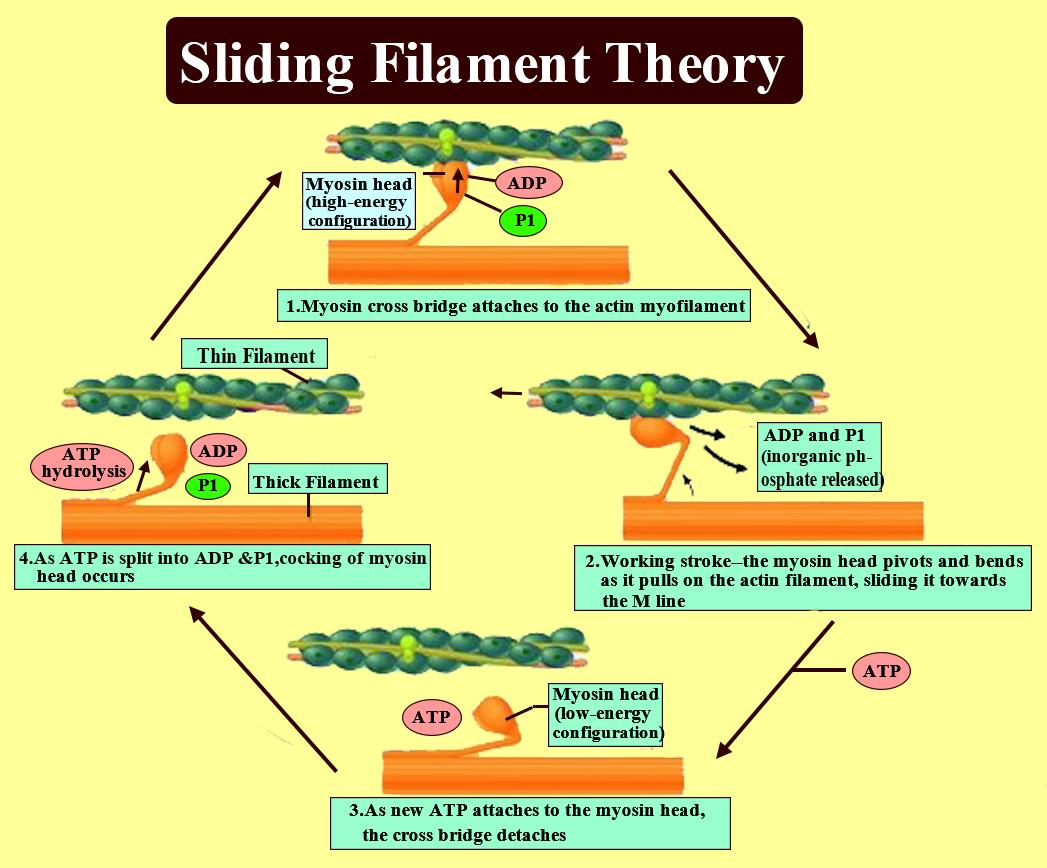
Sliding filament theory can be best explained as
(a)Actin and myosin filaments do not shorten but rather slide passes each other
(b)When the myofilaments slide passes each other myosin filament shortens, while actin filaments do not shorten.
(c)when myosin filament slide passes each other actin filaments shorten, while myosin filament does not shorten
(d)Actin and myosin filaments shorten and slide passes each other.
Answer
568.2k+ views
Hint: The ultrastructural changes during muscular contraction include the regular and cyclic attachment and detachments between the myosin cross-bridges and the actin filaments. These changes are best explained by the sliding filament theory of muscle contraction. According to this theory, muscle fibers become short and thick during contraction by the shortening of their sarcomeres. The shortening of the sarcomeres is not due to the contraction and shortening of myofilaments.
Complete answer:
During contraction, Actin filaments slide inward from adjacent Z-zones to the H-zone in between. In the H-zone they completely overlap the myosin filaments and link with them, forming actomyosin chains. This inward movement of actin filaments brings the Z-zones closer and closer together. So, the length of the I-band and that of sarcomere become progressively shorter and shorter. Since actin filaments from two sides ultimately meet together at the H-zone, the H-zone also becomes shorter and shorter and finally disappears. However, the length of the A band remains unchanged. The active sliding of actin filaments results from interactions between myosin cross bridges and actin filaments. During muscular contraction, the head of the myosin filament functions as a hook. It attaches to a binding site in the F-actin, forming a cross-bridge. Soon conformational changes take place in it, pulling the actin filaments further towards the H-zone in A-band. This shortens the sarcomere up to 30% of its length.
Additional Information: -The sliding filament theory is almost universally accepted today.
-However, the actual force-generating process often called the excitation-contraction-coupling mechanism is not fully understood
-Muscular contraction Is the shortening of myofibrils in response to nervous stimulation.
- During this actin filament slide over myosin filament and link with them, forming actomyosin complexes.
So, the correct answer is 'actin and myosin filament do not shorten rather slide passes each other.'
Note:
- The attachment-detachment cycle of myosin head, or simply the cross-bridge cycle may be repeated many times depending upon the speed or degree of contraction.
-The energy required for actin-myosin interaction is obtained by ATP breakdown, at the rate of one ATP molecule for every cross-bridge cycle.
-The formation of actomyosin is believed to activate the ATPase site by an allosteric mechanism. This in turn results in ATP hydrolysis. The free energy of this hydrolysis is utilized for the detachment of the myosin head.

Complete answer:
During contraction, Actin filaments slide inward from adjacent Z-zones to the H-zone in between. In the H-zone they completely overlap the myosin filaments and link with them, forming actomyosin chains. This inward movement of actin filaments brings the Z-zones closer and closer together. So, the length of the I-band and that of sarcomere become progressively shorter and shorter. Since actin filaments from two sides ultimately meet together at the H-zone, the H-zone also becomes shorter and shorter and finally disappears. However, the length of the A band remains unchanged. The active sliding of actin filaments results from interactions between myosin cross bridges and actin filaments. During muscular contraction, the head of the myosin filament functions as a hook. It attaches to a binding site in the F-actin, forming a cross-bridge. Soon conformational changes take place in it, pulling the actin filaments further towards the H-zone in A-band. This shortens the sarcomere up to 30% of its length.
Additional Information: -The sliding filament theory is almost universally accepted today.
-However, the actual force-generating process often called the excitation-contraction-coupling mechanism is not fully understood
-Muscular contraction Is the shortening of myofibrils in response to nervous stimulation.
- During this actin filament slide over myosin filament and link with them, forming actomyosin complexes.
So, the correct answer is 'actin and myosin filament do not shorten rather slide passes each other.'
Note:
- The attachment-detachment cycle of myosin head, or simply the cross-bridge cycle may be repeated many times depending upon the speed or degree of contraction.
-The energy required for actin-myosin interaction is obtained by ATP breakdown, at the rate of one ATP molecule for every cross-bridge cycle.
-The formation of actomyosin is believed to activate the ATPase site by an allosteric mechanism. This in turn results in ATP hydrolysis. The free energy of this hydrolysis is utilized for the detachment of the myosin head.

Recently Updated Pages
Why are manures considered better than fertilizers class 11 biology CBSE

Find the coordinates of the midpoint of the line segment class 11 maths CBSE

Distinguish between static friction limiting friction class 11 physics CBSE

The Chairman of the constituent Assembly was A Jawaharlal class 11 social science CBSE

The first National Commission on Labour NCL submitted class 11 social science CBSE

Number of all subshell of n + l 7 is A 4 B 5 C 6 D class 11 chemistry CBSE

Trending doubts
Differentiate between an exothermic and an endothermic class 11 chemistry CBSE

10 examples of friction in our daily life

One Metric ton is equal to kg A 10000 B 1000 C 100 class 11 physics CBSE

Difference Between Prokaryotic Cells and Eukaryotic Cells

1 Quintal is equal to a 110 kg b 10 kg c 100kg d 1000 class 11 physics CBSE

State the laws of reflection of light




